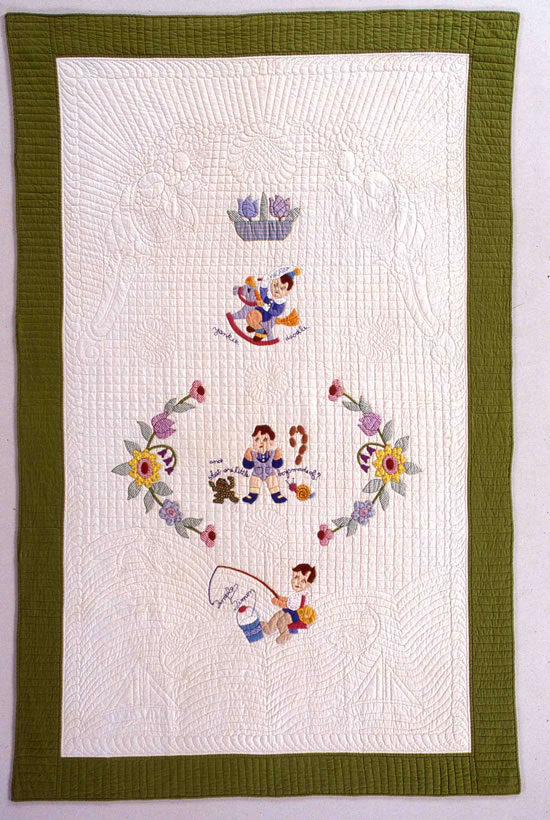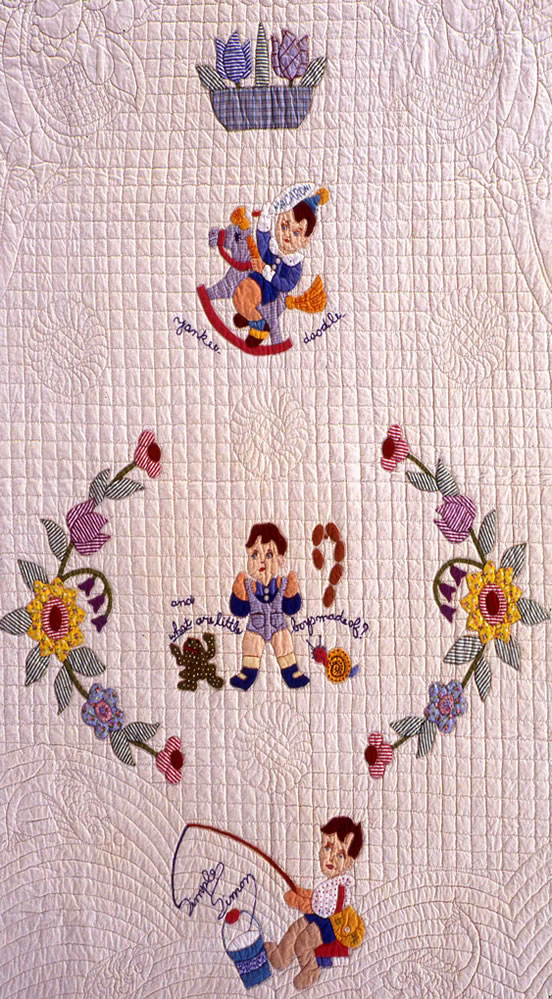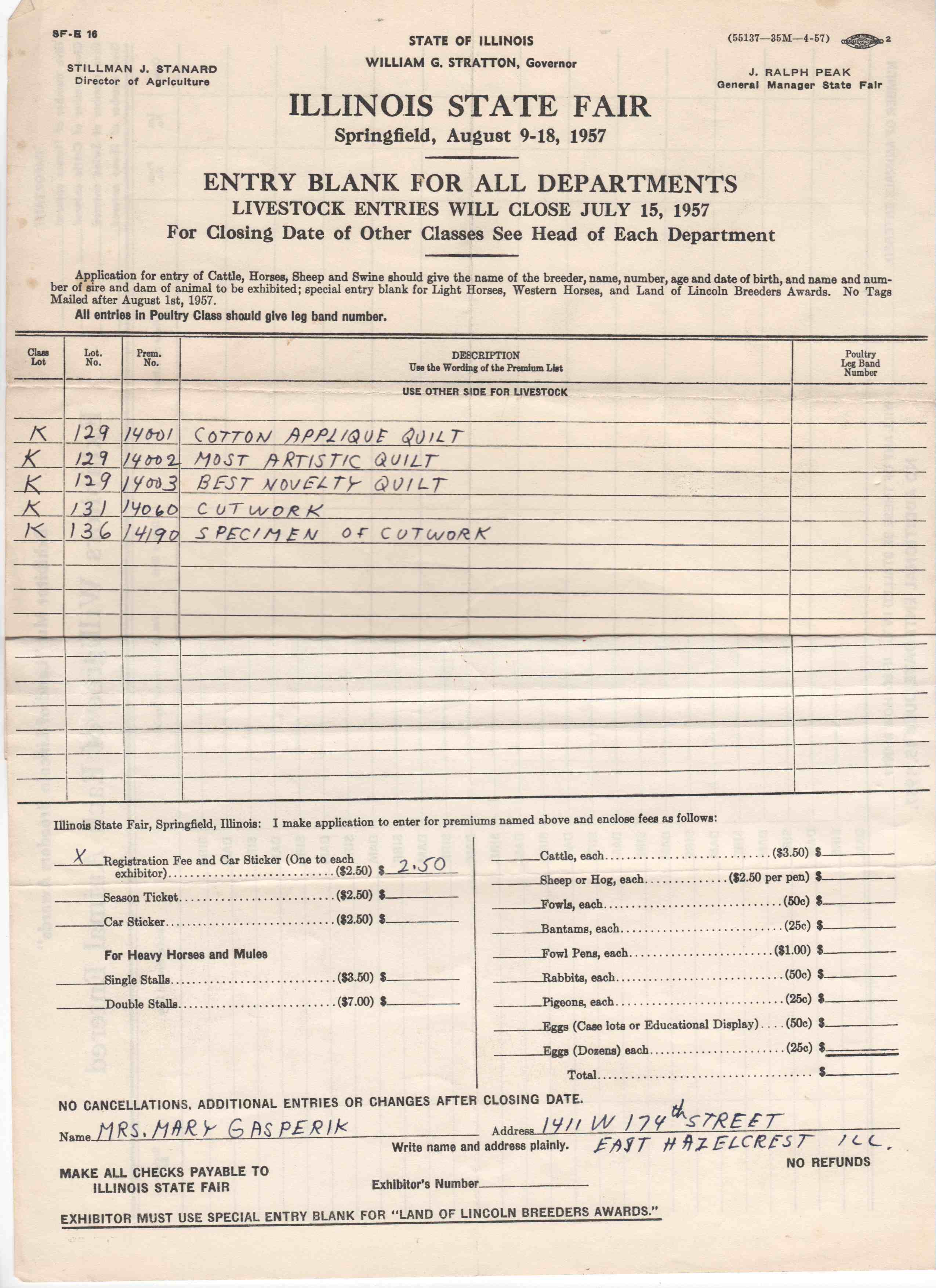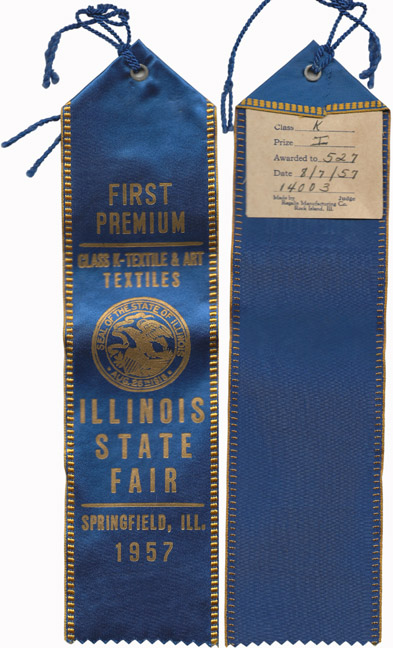
QUILT INDEX RECORD
18-14-57
Description:
In this crib quilt made for a great-grandson, she again revamped a 1930s pattern. See also Tuley Park Quilt Club and Detroit News Quilt Club#054, #075 and #008.
Where are the records for this quilt housed?
Mary Gasperik Legacy Project
Who documented this quilt?
Mary Gasperik Private Collection
Gasperik Legacy Project Number:
058
This is a:
Finished quilt
Quilt's title:
What Are Little Boys Made Of?
Owner's name for quilt:
What are Little Boys Made Of?
How wide is the quilt?
48 inches
How long is the quilt?
72 inches
Shape of edge:
Straight
Shape of corners:
Straight
What color is the quilt?
Blue or Navy; Gold; Gray; Green; Lavender; Rust; White
Overall color scheme:
Multicolor
Quilt's condition:
Excellent/like new
Type of inscription:
Message
What is inscribed on the quilt?
"What Are Little Boys Made Of" and "Yankee Doodle" and "Simple Simon"
Method used to make the inscription:
Embroidery
Location of inscription:
other
Describe where the inscription was found:
On front -- one per little boy figure.
Time period:
1950-1975
When was the quilt finished?
1957
Family/owner's date for quilt:
1957
Who estimated the quilt's date?
Merikay Waldvogel
Further information concerning dates:
Quilt for a great grandson born in 1957.
Describe the quilt's layout:
Medallion or framed center
Subject of the quilt:
nursery rhymes
Number of borders:
One
Describe the borders:
One wide green border on four sides. Just inside the green fabric border is a quilted border of feathering on white ground.
Fiber types used to make the quilt top:
Cotton
Fabric styles used in the quilt top:
Print; Solid/plain; Striped
Applique techniques used to make the quilt top:
Hand Applique
Embellishment techniques used to make the quilt top:
Embroidery; Other embellishment technique
Describe any unusual techniques used to make the quilt top:
The boys' garments include 'real' pockets and buttons.
Embellishments used:
Buttons attached
Materials used to make the back:
Cotton
Materials used in the quilt binding:
Cotton
What is the width of the binding (measure on the top only)?
less than a half inch
What kind of filling is used in the quilt?
Cotton
How thick is the quilt?
Thin (Less than 3/16
How are the layers held together?
Hand quilting
Can you see any knots on the front or back of the quilt?
no
Quilting designs used, overall motifs:
Grid square; Patches outlined/in the ditch; Other
Quilting designs used, decorative motifs:
Feathering; Wreaths; Other
Quilting designs used, background fills:
Grid/crosshatch; Parallel lines; Other
Describe the quilting designs used:
The quilting in the top half of the quilt resembles Gasperik's 'Indiana Wreath', including the large elaborate quilted cornucopias spilling fruit and flowers as well as the embedded feathered heart and feathered wreaths. In the lower half of the quilt Gasperik took her inspiration from the applique Simple Simon fisher-boy. She quilted elaborate wave patterns with embedded sailboats (2) and fish (3).
Features or notes about the quilt's appearance, materials, or construction:
It looks like two separate commercial sources were consulted in the design of the quilt top: one a pattern set for depicting nursery rhymes; and the other a kit containing the distinctive set of colored striped fabrics forming the applique flowers.
Quilt top made by:
Gasperik, Mary
Quilted by:
Gasperik, Mary
Where the quilt was made, city:
East Hazelcrest
Where the quilt was made, county:
Cook County
Where the quilt was made, state:
Illinois (IL)
Where the quilt was made, country:
United States
How was this quilt acquired?
Gift
Tell the story of how the quilt was obtained:
Given by Gasperik to her grand-daughter Karen in celebration of the birth of Karen's first child, Andy, who was also Gasperik's first great-grandchild.
Why was the quilt made?
Baby or crib
The quilt was made to be used for:
Bedding, special occasion
Quilt is presently used as:
Keepsake/memento
Describe present uses of the quilt:
Mary's grandchildren regard her quilts as a unique collection to be preserved and appreciated.
Where did the maker get their materials?
Purchased new
Where did the maker find their pattern?
Unknown
Where did the quiltmaker find the pattern for the quilting design on the quilt?
Published material
What is the commercial name of the quilting design used for this quilt?
Feathered wreath (Pattern B4 Grandmother's Perforated Quilting Patterns Package #32 WLM Clark, St. Louis, MO).
Fish quilted three times on this quilt is from Sheet 8 of Wonder Package (Embroidery Designs) (Chicago, IL, 1933).
Exhibitions where this quilt was displayed:
The Quilts of Mary Gasperik, Ravenswood Historic Site, Livermore, CA, March 14-15, 1992.
This is one of the 23 Mary Gasperik quilts exhibited in the Carnegie Room of the Marion Indiana Public Library July 16-17, 2021 in connection with the ceremony honoring the induction of Mary Gasperik into The Quilters Hall of Fame as their 2021 Legacy Quilter honoree. Mary Gasperik Quilters Hall of Fame Induction Exhibit.
Contests entered:
First prize, best novelty quilt, Illinois State Fair, 1957.
Publications (including web sites) where this quilt or maker was featured:
Merikay Waldvogel and Barbara Brackman. Patchwork Souvenirs of the 1933 Chicago World's Fair, (Nashville, TN: Rutledge Hill Press, 1993)102-103.
Merikay Waldvogel "One American Dream Comes True", Quilters Newsletter Magazine, March 2008, 46-49.
Related items such as diaries, obituaries, wills, household inventories, or pictures of the quiltmaker:
Sheet of embroidery transfers (with Fish) from The Wonder Package (Donald F. Duncan Inc., Chicago, 1933). Patterns found in this boxed package were also used to make the Japanese style lettering found in quilts: #020, #029, #040, #047, and #059, as the moon shaped appliques forming the four corners of quilt #048. The Wonder Package was available through The Detroit News, as well as newspaper advertisements.
Illinois State Fair 1957 blue ribbon (private collection of Karen Finn).
There is a family photograph showing young Andy Finn (for whom this quilt was made) with his great grandmother (who made it). In the photograph Gasperik is showing her great-grandson the quilt called Road to Recovery (#066). Gasperik's daughter Elsie is also in the picture.
Ownership of this quilt is:
Private
Quilt owner's name:
Karen Krueger Finn
Quilt owner's country:
United States
Person filling out this form is:
Relative of quiltmaker; Author/researcher
If you are a relative of the quiltmaker, how are you related? The quiltmaker is my:
Grandmother
Describe the relationship to the quilt's maker:
Grand-daughter Susan Salser began this research effort in 1991, after she and her two sisters divided up the quilts which belonged to their mother (Elsie Gasperik Krueger) who died in 1988. Her ongoing research has been fruitful and interesting.
Quiltmaker's maiden name:
Mihalovits, Maria
Quiltmaker's gender:
Female
Quiltmaker's birth date:
01/25/1888
Quiltmaker's birthplace, country:
Hungary
Quiltmaker's marriage date(s):
11/18/1906
Quiltmaker's date of death:
05/25/1969
Quiltmaker's ethnic background/tribal affiliation:
Hungarian
Quiltmaker's educational background:
Elementary School
In which kind of environment did the quiltmaker live?
Rural
Quiltmaker's city:
Chicago
Quiltmaker's county:
Cook
Quiltmaker's state:
Illinois (IL)
Quiltmaker's country:
United States
Quiltmaker's father's name:
Mihalovits, Istvan
Quiltmaker's father's birthplace:
Hungary
Quiltmaker's father's ethnic/tribal background:
Hungarian
Quiltmaker's mother's name:
Mihalovits, Vidoszava
Quiltmaker's mother's birthplace:
Hungary
Quiltmaker's mother's ethnic/tribal background:
Hungarian
Quiltmaker's spouse's/spouses' and /or partner's/partners' name(s):
Gasperik, Stephen
Quiltmaker's spouse's/spouses' and/or partner's/partners' ethnic/tribal background:
Hungarian
Quiltmaker's spouse's/spouses' and/or partner's/partners' occupation:
Milk Dealer/Grocery Store Owner/Butcher
Number of children:
3
How many of the quiltmaker's children were girls?
1 (Elsie 1909-1988)
How many of the quiltmaker's children were boys?
2 (Elmer and Stephen)
How did the quiltmaker learn to quilt?
From guild or club member; Self-Taught
When did the quiltmaker learn to quilt?
Age 40-49
Why does the quiltmaker quilt?
Pleasure; Other
Other notes on how the quiltmaker learned, and how and why they quilt:
Mary Gasperik made quilts because it was her life passion and greatest talent. As opportunities arose, she entered contests and exhibited them publicly. She also made special quilts for her family.
Does/did the quiltmaker belong to a group? Name of the group?
Tuley Park Quilt Club and Detroit News Quilt Club
Does/did the quiltmaker belong to a group?
Southside Chicago and Detroit MI
What are the main activities of the group?
Chicago group met to quilt and held periodic quilt show; Detroit group held national exhibits and contests.
Estimated number of quilts made by this quiltmaker:
more than 50
Does/did the quiltmaker sell quilts?
no
Does/did the quiltmaker teach quilting?
no
Who photographed this quilt?
Don Gonzalez
Access and copyright information:
Restricted
Copyright holder:
Susan Salser
Details
Cite this Quilt
Gasperik, Mar. What Are Little Boys Made Of?. 1957. From Mary Gasperik Legacy Project, Mary Gasperik Private Collection. Published in The Quilt Index, https://quiltindex.org/view/?type=fullrec&kid=18-14-57. Accessed: 04/27/24
-
Gallery
Gasperik 05: Gifts for Children
Waldvogel, Merikay
-
Gallery
Gasperik 08: Mystery Quilts - Unidenti...
Waldvogel, Merikay
-
Exhibit
The Quilts of Mary Gasperik
Salser, Susan
-
Ephemera
The Quilts of Mary Gasperik
Salser, Susan
-
Exhibit
Mary Gasperik Quilters Hall of Fame In...
Salser, Susan
-
Ephemera
Quilt History Tidbits #43 - Wonder Pac...
Quilt History Tidbits
-
Gasperik, Mary Quiltmaker
Mary Gasperik Legacy Project
-
1940
What Are Little B... Gasperik, Mary
-
1940
What Are Little G... Gasperik, Mary
-
1940-1954
Sugar and Spice Gasperik, Mary
-
1940
What Are Little G... Gasperik, Mary
-
1940-1954
Sugar and Spice Gasperik, Mary


